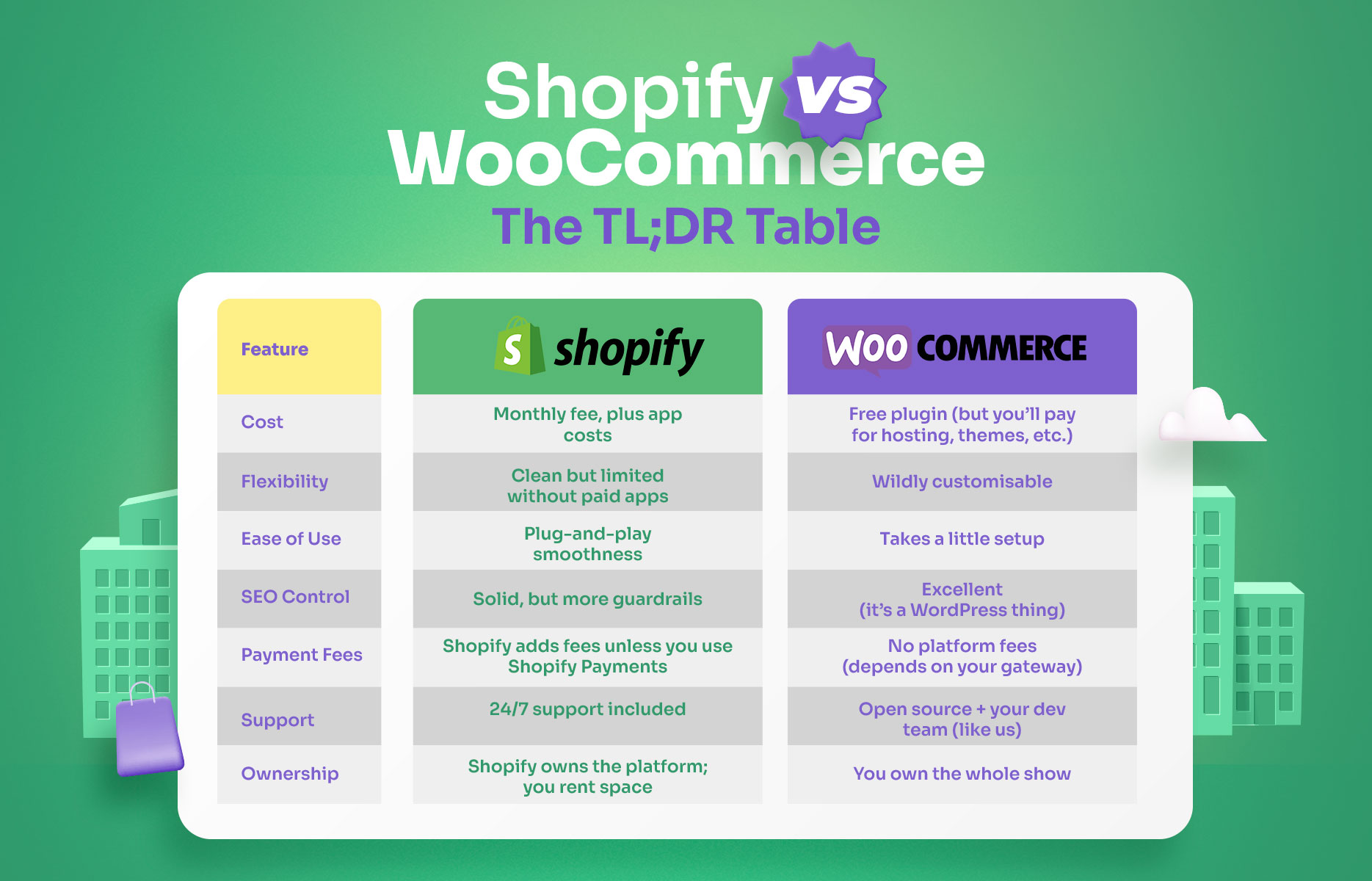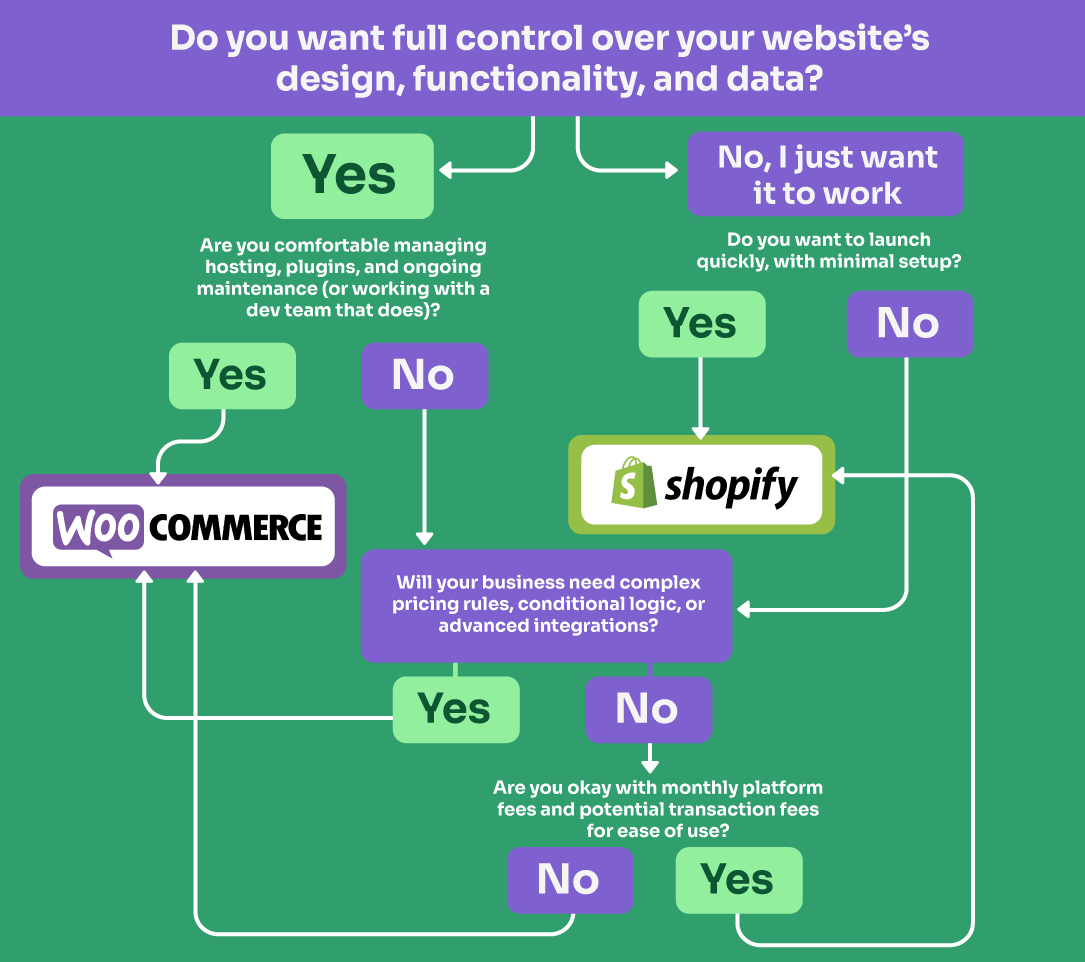Shopify or WooCommerce?
Which one deserves your add to cart?
Choosing an eCommerce platform is a bit like choosing a housemate. You want something reliable, easy to live with, and unlikely to break the internet the moment you add a new plugin.
Two names always pop up: Shopify and WooCommerce.
Both are powerful. Both are wildly popular. And both will let you sell socks, soap, or software subscriptions from the comfort of your browser. But they’re not interchangeable.
We’ve built and wrangled our fair share of online stores at Dweebi, and while we’re WooCommerce whizzes, we’re not here to convince you of anything that doesn’t make sense for your business. So this is the no-spin, no-nonsense breakdown of Shopify vs WooCommerce, based on actual use cases, not platform loyalty.
When Shopify is the Right Choice
We’ll be straight, Shopify is convenient. If you’re a solo operator or new to eComm, it might be exactly what you need.
- You want to get selling this week, not next quarter.
- You don’t want to think about hosting, backups, or updates.
- You’d rather pay a monthly fee than piece together your tech stack.
- You want decent out-of-the-box design and UX.
- You’re doing dropshipping or low-maintenance products.
Shopify keeps things tidy and contained. You log in, load up your products, pick a clean theme, and voilà, you’ve got a store.
But… if you want to do anything a little unusual, expect to hit some walls. Shopify’s great until you try to step outside the sandbox.
- Custom checkouts? Pay extra.
- Niche product flows? App required.
- Advanced SEO? It’s doable, but you’re limited.
- Want to fully control the look and feel? You’ll need a dev (and their toolkit is restricted compared to WooCommerce).
When WooCommerce Wins the Day
WooCommerce is the “choose your own adventure” of online selling. It’s a WordPress plugin, which means if you can imagine it, you can probably build it. WooCommerce is a great choice if:
- You want full control over design, functionality, and SEO.
- You need advanced product rules (subscriptions, bundles, custom pricing).
- You care about data ownership and portability.
- You’re already using WordPress, or you’re happy to go that route.
- You want to scale your store without scaling your costs.
The learning curve is a little steeper, sure. But when you pair WooCommerce with a team (hi, that’s us 👋) who knows how to tame it, the result is a store that looks, feels, and works exactly the way you need. No compromise, no platform limits.
Real World Examples
Bellbird Boutique – Shopify
Bellbird Boutique came to us for branding and digital assets as they prepared to launch their baby and children’s goods store. They explored both platforms, but ultimately chose Shopify.
Why? It was faster to set up, easier to maintain, and gave them everything they needed for a clean, modern online store – without having to worry about hosting, updates, or plugins. For a founder juggling product, marketing, and sleep schedules (because… babies), Shopify’s simplicity won out.
Buy Turf Online – WooCommerce
On the other hand, Buy Turf Online needed more control from the get-go.
Their site required:
- Conditional pricing (different rates for trade vs residential customers)
- Complex shipping rules (based on product type and weight)
- A growing content library of lawn care guides, optimised for SEO
We built their store on WooCommerce, using Divi Builder to give them maximum control over layout and updates. The result? A tailored experience for every user segment, and a website that works as hard as their team does.
So, Which Platform Suits You?
As we’ve said before, your platform choice should match your business strategy. So we’ve put together a few quick examles to help you get started.
If you’re…
- Launching a product line next week.
Go with Shopify. The speed and simplicity are hard to beat. - Putting together a long-term SEO strategy and want every pixel just so.
WooCommerce wins. You’ll get full control and performance benefits. - Scaling fast, with complex SKUs and customer logic.
Definitely WooCommerce. Shopify gets pricey with scaling complexity. - Testing a concept, unsure if it’ll fly.
Shopify’s low setup time makes it perfect for MVPs. - Wanting a forever-home platform that can adapt over time.
WooCommerce. You own the site, the code, the data… forever.
Other Factors to Consider
Ownership gives you Freedom (and Future-Proofing)
With WooCommerce, you own everything – your code, your content, your customers, your checkout flow, all of it. You’re not tied to someone else’s roadmap, pricing model, or T&Cs.
Shopify? You’re essentially renting a storefront in their mall. It’s polished and managed, but they still hold the keys.
Performance and SEO – Control vs Convenience
Shopify is fast right out of the box, which is great for smaller stores with minimal traffic.
WooCommerce can be just as fast (if not faster), but it depends on how it’s set up – hosting, caching, CDNs, plugins. The trade-off? You control it.
And when it comes to SEO, WooCommerce on WordPress is a powerhouse. Schema markup, custom URLs, advanced metadata, if you’re serious about organic search, WooCommerce gives you room to grow.
Security and Compliance
Shopify handles PCI compliance, SSL, and other security stuff for you. Great if you want it off your plate.
With WooCommerce, you’re responsible, but that also means you can go beyond the basics. Need ISO-level security? Need to comply with NDIS, HIPAA, or other local industry-specific regulations? WooCommerce gives you room to configure, audit, and document. This is especially important for finance, healthcare and regulated sectors.
WooCommerce or Shopify? Here’s our Take
At Dweebi, we specialise in WooCommerce because most of our clients need:
- A store that matches their business logic, not restricts it.
- SEO that works like a dream.
- Control over customer experience.
- Scalability without arbitrary fees.
And frankly, we’re good at making WooCommerce feel like Shopify when it comes to usability. So you get the best of both worlds – power without pain.
But hey, we’ve also told clients to go with Shopify when it makes more sense. If you’re running a low-touch product line, or you want to dip a toe into online sales, it’s a fine option.
Still not Sure? Let’s Chat!
We offer no-pressure strategy chats to help you work this out. Even if that means pointing you away from what we do.
Let’s have a call, we’ll help you pick the right platform. And, if it’s WooCommerce, we’ll make it work like a dream.

read more!
recent posts
How to Design a Vehicle Wrap That Actually Gets Noticed
Discover how to design a vehicle wrap that gets your business noticed. From smart layouts to real-world examples, this is your vehicle wrap design playbook.
Unlocking the Value of Graphic Design Subscriptions
Why Smart Marketers Outsource Graphic Design And How to Do It Right!Why businesses choose a subscription model Benefits of a graphic design subscription Traps to look out for Subscription pricing models How to maximise your design subscriptionWhy businesses choose a...
Why Smart Marketers Outsource Graphic Design – And How to Do It Right
Why Smart Marketers Outsource Graphic Design And How to Do It Right!Why outsource your graphic design Graphic design outsourcing options How to outsource graphic designWhy outsource your graphic design Graphic design outsourcing options How to outsource graphic...









